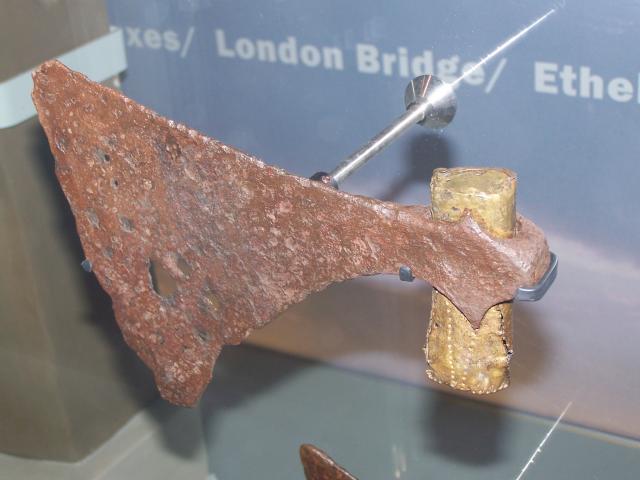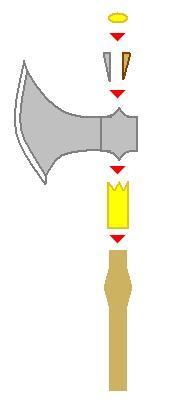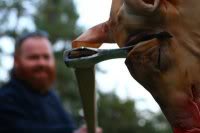| Author |
Message |
|
Ted Bouck
Location: Northe East Ohio Joined: 04 Jul 2007
Posts: 20
|
 Posted: Tue 10 Feb, 2009 8:10 pm Post subject: Dane 2-handed axe "Haft" design Posted: Tue 10 Feb, 2009 8:10 pm Post subject: Dane 2-handed axe "Haft" design |
 |
|
I am working on a froged Type L axe, and the forged aspect is complete. I plan on showing some pics, or at least a link to some pics, but my camera is not to be found presently.
I do want to make a nice ash haft for it, and have not found any good reference for the shape and specific designs that were , or might have been used in the 10-11th Century? There is some Varangian iconography, and Hurstwic has a good page on axes, but really nothing period I could locate.
I am interested in the method of attaching the haft to the eye so that it won't be loose, and how the haft would have been counter-balanced to provide the proper balance for the manipulation of the axe in use.
All help is appreciated!
Sincerely,
Ted
|
|
   |
 |
Gavin Kisebach

|
 Posted: Thu 12 Feb, 2009 2:12 am Post subject: Posted: Thu 12 Feb, 2009 2:12 am Post subject: |
 |
|
Hey Ted,
Apparently I'm the only other person losing sleep over this so I'll give you what I've got thus far. I have a type M axe, which has a temporary haft and is just waiting for me to wade through fifteen or twenty other projects to get a special haft that I have in mind.
I like oak for long axe handles as it feels more rigid to me than ash. The other advantage of oak is that it's slightly more dense, so counters the head weight just a bit better.
As far as I have gleaned the method of securing axe heads hasn't changed much for thousands of years, because it works. The only variation seems to be whether you slide the head up from the bottom of the haft, which flares at the top, or slide the head down to a bulge just below the top. The head goes on, followed by a wooden wedge and an iron wedge set perpendicular to each other.
I like the latter method, because all of my top flare throwing axes come loose constantly, and any attempt to fix them permanently just tears up the haft and then slides loose anyhow.
The only really interesting feature that I've found is pictured below on a large axe head from England. On closer inspection it appears to be a sheet of brass wrapped around the haft, with a little crown shape cut into the top edge. There is a separate disc which gets placed over the wedges, and then the crown is folded over to hold the disc in place. My crude illustration below shows how this might work. The soft metal is decorative sure, but might also protect the haft from rot, wear, and tear.
Another interesting (though purely hypothetical) point that is that these later large axes have enough of an upper horn to use for a rudimentary thrust. We tried this with my axe when I first got it, and the haft snapped about six inches below the head. When thrusting with the tip of the upper horn If you follow the line of the cutting edge back from the horn, it points to a spot on the haft about six inches below the head. This is where all the stress of the thrust seems to be going, and putting a thin sheet of metal around this area might be just enough to reinforce this point. Unfortunately there is no evidence to back this other than my personal fiddling. None of the capped axes that I have seen extend that for down, but I plan to make a brass cap that extends down to this "weak point".
As far as counterbalance, who knows? I haven't found any examples from finds or period depictions, so I have to assume for now that counterbalances weren't used. That said, I plan to put a matching brass cap on the butt of my axe haft. I am looking into making a weighted made because these larger heads just seem to cry out for it performance wise. something like a heavy brass knob might do the trick without adding to much weight.
I hope that helps.
 Attachment: 34.12 KB Attachment: 34.12 KB

Haft Cap
 Attachment: 5.7 KB Attachment: 5.7 KB

There are only two kinds of scholars; those who love ideas and those who hate them. ~ Emile Chartier
|
|
   |
 |
D. Austin
Industry Professional

Location: Melbourne, Australia Joined: 20 Sep 2007
Posts: 208
|
 Posted: Thu 12 Feb, 2009 3:52 am Post subject: Posted: Thu 12 Feb, 2009 3:52 am Post subject: |
 |
|
Hi Ted,
Glad to hear it's coming along well. I'd definitely second Gavin's recommendation of sliding the head on from the top and securing it with wedges. The wooden one should be in line with the grain and the steel one at right angles to it. The end of the haft should fit the eye of the axe well prior to securing with wedges, to prevent loosening. I'd also recommend not thrusting with your axe (I'm just not convinced that it's a good idea). 
From period pictures I've seen, I'd assume that the haft would be either oval or egg shaped in cross section. I can't find a picture at the moment, but a slight kick at the end, like a crude version of that found on modern axe hafts, can help prevent it slipping from your hands.
I'm not sure that there would be a counter balance on such a weapon. If it was used for great cleaving cuts (as an axe is greatly suited to), a point of balance very close to the head would be desirable. I tend to imagine these weapons being used more like wood chopping tools than agile weapons like swords.
Hoping your camera turns up soon,
Darren.
|
|
  |
 |
|
Justin King
Industry Professional
|
 Posted: Thu 12 Feb, 2009 6:32 am Post subject: Posted: Thu 12 Feb, 2009 6:32 am Post subject: |
 |
|
From years of using and mounting hammer and axe heads, I have learned that 5/16" or 3/8" diameter lag bolts can be used in place of the steel wedge and last much longer without backing out. I buy cheap ones that are made out of relatively soft steel, make a little hole in the middle of the wooden wedge (after it has been driven in and cut off flush) to start the bolts in using a hammer and a nail or punch, and then screw them in an inch or so. Then I cut the rest of the bolt off flush with a hacksaw. I tend to use smaller bolts so that I can add more if and when they are needed. This probably sounds like a lot of trouble but I have found it to be a significant improvement over the steel wedges.
Placing the axe head-down into a tub or bucket filled with linseed or tung oil so that the end of the haft is immersed for a couple of days will cause the wood inside the eye to swell, tightening the joint, and it also seals the wood against rot inside the eye.
|
|
  |
 |
|
Audun Refsahl
Location: Norway Joined: 15 Feb 2006
Posts: 82
|
 Posted: Thu 12 Feb, 2009 8:21 am Post subject: Posted: Thu 12 Feb, 2009 8:21 am Post subject: |
 |
|
I find this idea that the dane axe is made for wood chopping style blows and that you need lots of room to use it a little strange. I have used these for a couple of years now, in reenactment battles, and I have tested all my techniques with a sharp replica to make sure it is as authentic as possible. the most effective techniques are stabbing and hooking, and fast cuts with maybe 1 meter swing. all of these attacks will split a pigs head or dig 10 cm or more into its flesh. In a true fight you would only use a really strong blow for the last finishing blow. with these techniques you don't need more space than any other polearm, like glaive etc, and it is very effective in closed lines.
I think it's a great idea to stab and hook with your axe, you should secure the head enough to be able to do that, and try it out, it's amazingly effective.

just bacon...
|
|
   |
 |
Gavin Kisebach

|
 Posted: Thu 12 Feb, 2009 6:07 pm Post subject: Posted: Thu 12 Feb, 2009 6:07 pm Post subject: |
 |
|
Audun this is similar to what my friend who has spent years fighting with a longaxe in the SCA has concluded.
It is true that a large, sweeping strike would be devastating to anything in its path, but the blow likely wouldn't land against anything but the most static of targets, like perhaps a very tight shieldwall. I can imagine the horror of a dozen thegns in fine maille smashing a shieldwall to bits, but not for long. Any army that wanted to live would quickly respond with long spears, arrows or javelins, all of which seem to handle greatweapon wielders rather well.
So my friend fights a lot with his hands choked up as you would expect to see on a poleaxe, making lots of (still powerful) smaller chops at the arms and legs, and he has enough power to push your shield aside entirely and strike to your ribs. The shortened grip also allows him to block, trip, crosscheck, and jab with the haft of the weapon. It's so effective that the oft described "sweeping arcs" theory just doesn't sit well with me anymore.
There are only two kinds of scholars; those who love ideas and those who hate them. ~ Emile Chartier
|
|
   |
 |
|
Patrick Kelly
|
 Posted: Thu 12 Feb, 2009 6:14 pm Post subject: Posted: Thu 12 Feb, 2009 6:14 pm Post subject: |
 |
|
My experience with this type of weapon also corelates with Auduns.


A large scything blow with this weapon would certainly be effective and I'm fairly sure that must have been done in certain circumstances. However, with the long haft acting as a lever, a large amount of power is generated on the head end with minimal movement applied on the back end. Large bold movements aren't really neccesary to make this weapon effective.
|
|
   |
 |
|
Hanns Wiechman
Location: Minneapolis, MN Joined: 17 Jun 2007
Posts: 21
|
 Posted: Thu 12 Feb, 2009 9:12 pm Post subject: Posted: Thu 12 Feb, 2009 9:12 pm Post subject: |
 |
|
Patrick, what's the length and weight of that beast? TIA,
Hanns
|
|
  |
 |
|
Patrick Kelly
|
 Posted: Thu 12 Feb, 2009 9:51 pm Post subject: Posted: Thu 12 Feb, 2009 9:51 pm Post subject: |
 |
|
| Hanns Wiechman wrote: | Patrick, what's the length and weight of that beast? TIA,
Hanns |
The length is five feet. I can't remember the weight but I'll check it and get back to you.
|
|
   |
 |
Allen Foster

|
 Posted: Fri 13 Feb, 2009 5:17 am Post subject: Posted: Fri 13 Feb, 2009 5:17 am Post subject: |
 |
|
Would you mind telling us who made that Axe for you? That is one beautiful piece.
"Rise up, O Lord, and may thy enemies be dispersed and those who hate thee be driven from thy face."
|
|
   |
 |
|
Patrick Kelly
|
 Posted: Fri 13 Feb, 2009 5:41 am Post subject: Posted: Fri 13 Feb, 2009 5:41 am Post subject: |
 |
|
| Allen Foster wrote: | | Would you mind telling us who made that Axe for you? That is one beautiful piece. |
Thanks, it's one of my favorite pieces. Eric McHugh made it for me. He participates here on the forums so contacting him shouldn't be hard. He did do a beautiful job in recreating the original he documented during a research trip to Sweden.
A few more photos:



The original:

|
|
   |
 |
M. Eversberg II

|
 Posted: Fri 13 Feb, 2009 6:08 am Post subject: Posted: Fri 13 Feb, 2009 6:08 am Post subject: |
 |
|
Oh, the envy! Do you fence with the lenge axe?
M.
This space for rent or lease.
|
|
      |
 |
|
Patrick Kelly
|
 Posted: Fri 13 Feb, 2009 6:20 am Post subject: Posted: Fri 13 Feb, 2009 6:20 am Post subject: |
 |
|
| M. Eversberg II wrote: | Oh, the envy! Do you fence with the lenge axe?
M. |
As of yet no. This one's rather sharp and would definitely leave a mark! I sure get looks walking around a ren faire with it. Years ago I had some experience with oriental staff weapons and many of those techniques seem to translate well to this axe. I wish we had period texts available on the use of this weapon as with later periods, I suspect there's more to the technique than commonly assumed.
|
|
   |
 |
|
Curt Cummins
Location: Portland, OR Joined: 03 May 2007
Posts: 63
|
 Posted: Fri 13 Feb, 2009 7:05 am Post subject: Posted: Fri 13 Feb, 2009 7:05 am Post subject: |
 |
|
Question. On the historical axes, is the eye of the axe straight walled or tapered? If it is tapered, is the narrow end of the taper oriented down?
If the eyes are straight walled, this would suggest a conventional style mounting for axes and hammers. Handle below the axe is larger than the eye, and the head is locked with a wedge. If the eye is tapered, this would suggest a handle that is larger than the axe at the top and is slid though the eye butt first. Like a pick or an old style heavy hoe.
Curt.
Ye braggarts and awe be a'skeered and awa, frae Brandoch Daha
|
|
  |
 |
|
|
You cannot post new topics in this forum
You cannot reply to topics in this forum
You cannot edit your posts in this forum
You cannot delete your posts in this forum
You cannot vote in polls in this forum
You cannot attach files in this forum
You can download files in this forum
|
All contents © Copyright 2003-2025 myArmoury.com — All rights reserved
Discussion forums powered by phpBB © The phpBB Group
Switch to the Basic Low-bandwidth Version of the forum
|

